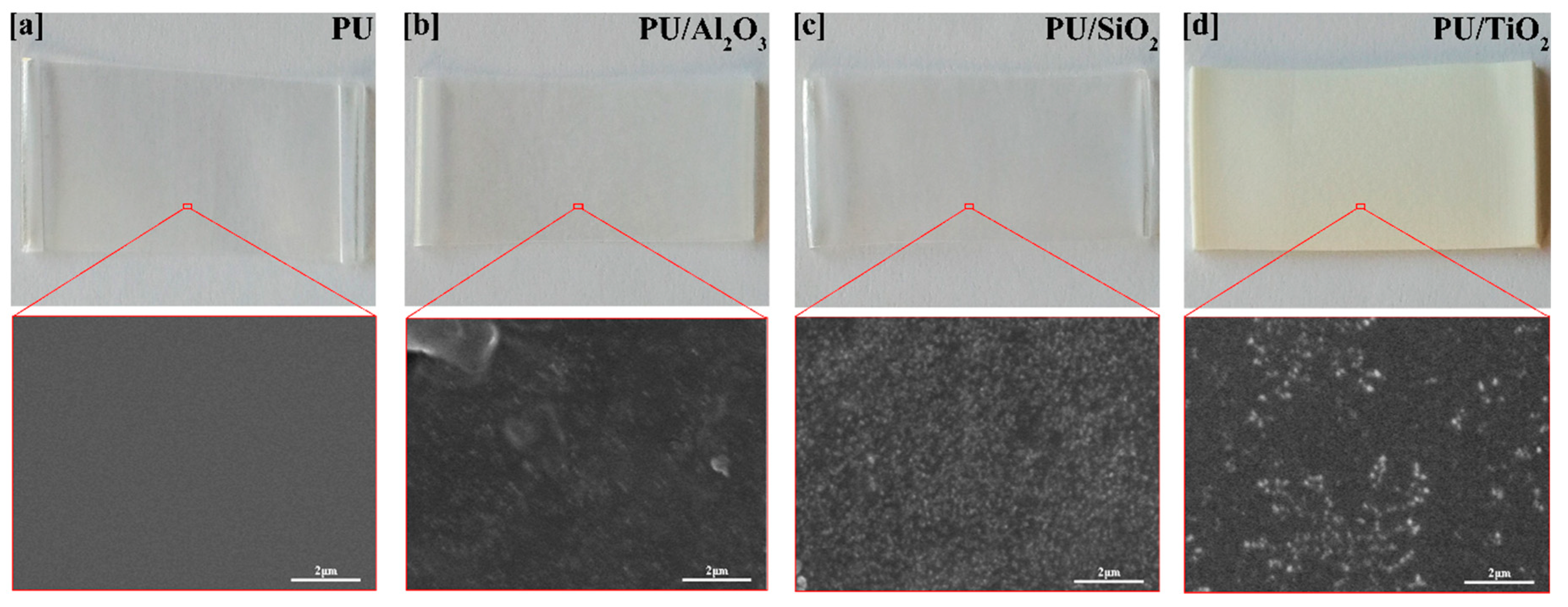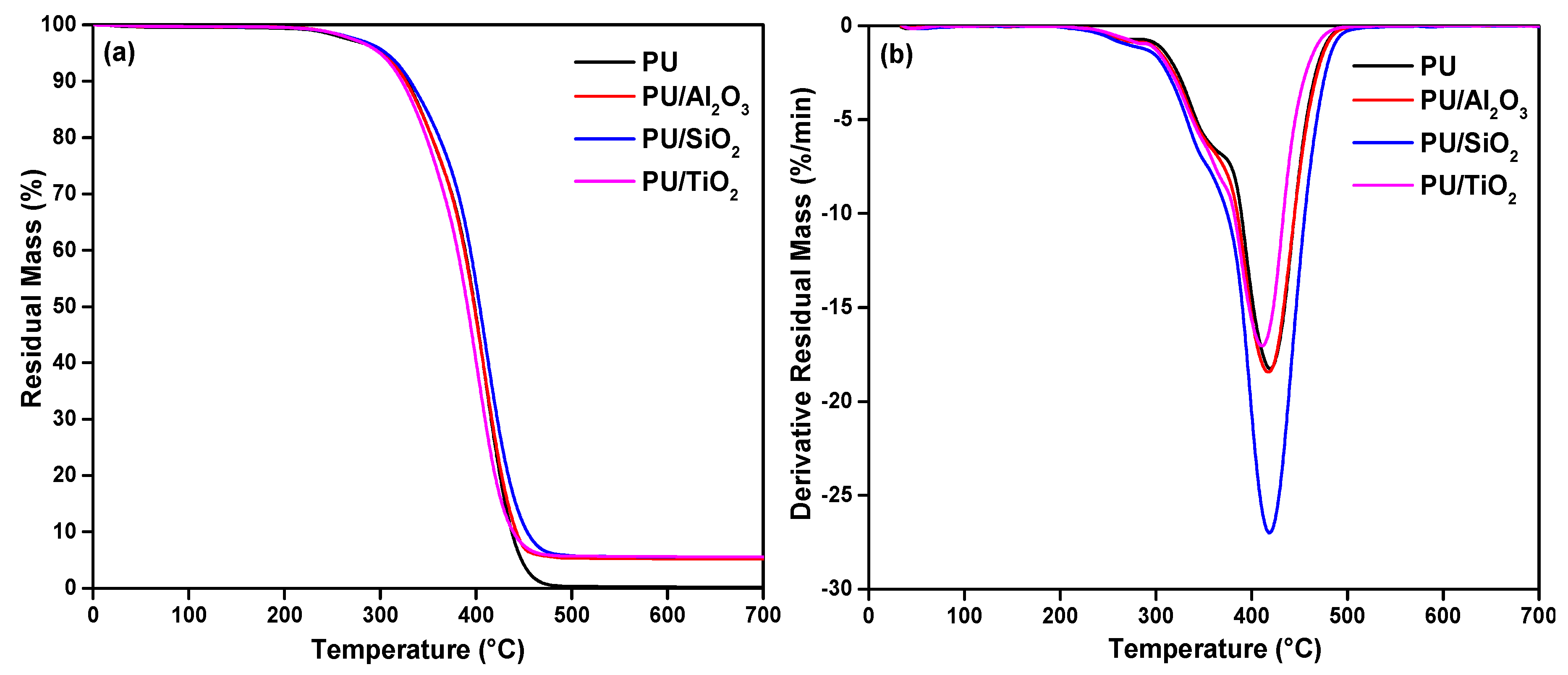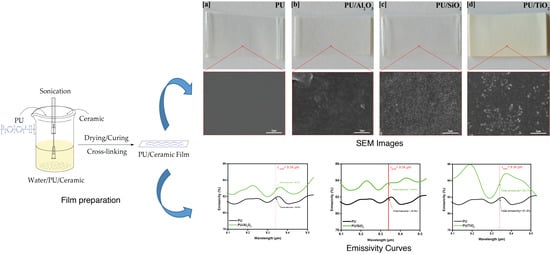Far-Infrared Emission Properties and Thermogravimetric Analysis of Ceramic-Embedded Polyurethane Films
Abstract
1. Introduction
2. Materials and Methods
3. Results and Discussion
3.1. SEM Analysis of Composite Films
3.2. FIR Emission Properties of Composite Films
3.3. TG Properties of Composite Films
3.4. Mechanical Properties of Composite Films
3.5. Contact Angle Analysis of Composite Films
4. Conclusions
Author Contributions
Funding
Institutional Review Board Statement
Informed Consent Statement
Data Availability Statement
Acknowledgments
Conflicts of Interest
References
- Tielemans, M.; Bleus, J.-P. New radiation-curable polyurethane dispersions for outdoor application on wood. In Proceedings of the 5th International Woodcoatings Congress, Prague, Czech Republic, 17–18 October 2006. [Google Scholar]
- Saha, S.; Kocaefe, D.; Boluk, Y.; Pichette, A. Surface degradation of CeO2 stabilized acrylic polyurethane coated thermally treated jack pine during accelerated weathering. Appl. Surf. Sci. 2013, 276, 86–94. [Google Scholar] [CrossRef]
- Patti, A.; Acierno, D. The effect of silica/polyurethane waterborne dispersion on the perforating features of impregnated polypropylene-based fabric. Text. Res. J. 2019, 90, 1201–1211. [Google Scholar] [CrossRef]
- Xiong, Y.; Zou, Y.; Cai, S.; Liu, H.; Huang, S.; Li, H. Processing and characterization of polymer-based far-infrared composite materials. Polymers 2019, 11, 1451. [Google Scholar] [CrossRef] [PubMed]
- Qiu, F.; Xu, H.; Wang, Y.; Xu, J.; Yang, D. Preparation, characterization and properties of UV-curable waterborne polyurethane acrylate/SiO2 coating. J. Coatings Technol. Res. 2012, 9, 503–514. [Google Scholar] [CrossRef]
- Caminero, M.Á.; Chacón, J.M.; García-Plaza, E.; Núñez, P.J.; Reverte, J.M.; Becar, J.P. Additive manufacturing of PLA-based composites using fused filament fabrication: Effect of graphene nanoplatelet reinforcement on mechanical properties, dimensional accuracy and texture. Polymers 2019, 11, 799. [Google Scholar] [CrossRef] [PubMed]
- Heidarian, M.; Shishesaz, M.R.; Kassiriha, S.M.; Nematollahi, M. Characterization of structure and corrosion resistivity of polyurethane/organoclay nanocomposite coatings prepared through an ultrasonication assisted process. Prog. Org. Coat. 2010, 68, 180–188. [Google Scholar] [CrossRef]
- Rosu, D.; Rosu, L.; Cascaval, C.N. IR-change and yellowing of polyurethane as a result of UV irradiation. Polym. Degrad. Stab. 2009, 94, 591–596. [Google Scholar] [CrossRef]
- Saha, S.; Kocaefe, D.; Krause, C.; Larouche, T. Effect of Titania and zinc oxide particles on acrylic polyurethane coating performance. Prog. Org. Coat. 2011, 70, 170–177. [Google Scholar] [CrossRef]
- Figueira, R.B.; Silva, C.J.R.; Pereira, E.V. Organic–inorganic hybrid sol–gel coatings for metal corrosion protection: A review of recent progress. J. Coat. Technol. Res. 2015, 12, 1–35. [Google Scholar] [CrossRef]
- Wang, X.; Hu, J.; Li, Y.; Zhang, J.; Ding, Y. The surface properties and corrosion resistance of fluorinated polyurethane coatings. J. Fluor. Chem. 2015, 176, 14–19. [Google Scholar] [CrossRef]
- Bautista, Y.; Gomez, M.; Ribes, C.; Sanz, V. Relation between the scratch resistance and the chemical structure of organic–inorganic hybrid coatings. Prog. Org. Coat. 2011, 70, 358–364. [Google Scholar] [CrossRef]
- Saadat-Monfared, A.; Mohseni, M.; Tabatabaei, M.H. Polyurethane nanocomposite films containing nano-cerium oxide as UV absorber. Part 1. Static and dynamic light scattering, small angle neutron scattering and optical studies. Colloids Surf. A Physicochem. Eng. Asp. 2012, 408, 64–70. [Google Scholar] [CrossRef]
- Kubiliene, D.; Sankauskaite, A.; Abraitiene, A.; Krauledas, S.; Barauskas, R. Investigation of thermal properties of ceramic-containing knitted textile materials. Fibres Text. East. Eur. 2016, 24, 63–66. [Google Scholar] [CrossRef][Green Version]
- Bartl, J.; Baranek, M. Emissivity of aluminium and its importance for radiometric measurement. Meas. Sci. Rev. 2004, 4, 31–36. [Google Scholar]
- Abbas, A.; Zhao, Y.; Ali, U.; Lin, T. Improving heat-retaining property of cotton fabrics through surface coatings. J. Text. Inst. 2017, 108, 1–7. [Google Scholar] [CrossRef]
- Rosace, G.; Guido, E.; Colleoni, C.; Barigozzi, G. Influence of textile structure and silica based finishing on thermal insulation properties of cotton fabrics. Int. J. Polym. Sci. 2016, 2016, 1–10. [Google Scholar] [CrossRef]
- Wang, Z.; Wang, Y.; Liu, Y.; Xu, J.; Guo, L.; Zhou, Y.; Ouyang, J.; Dai, J. Microstructure and infrared emissivity property of coating containing TiO2 formed on titanium alloy by microarc oxidation. Curr. Appl. Phys. 2011, 11, 1405–1409. [Google Scholar] [CrossRef]
- Hanada, T.; Aikawa, T.; Soga, N. ChemInform abstract: Physical properties and structure of rf-sputtered amorphous films in the system titania-silica. Chem. Inf. 1984, 15, 52–56. [Google Scholar] [CrossRef]
- Faisal, A.M.; Salaün, F.; Giraud, S.; Ferri, A.; Chen, Y.; Wang, L. Analysis of the thermal comfort properties and FIR infrared emission characteristics of ceramic nanofillers imbedded fabrics. In Proceedings of the 19th World Textile Conference-Autex, Ghent, Belgium, 11–15 June 2019; p. 3. [Google Scholar]
- Wang, H.-F. Bone and joint protection ability of ceramic material with biological effects. Chin. J. Physiol. 2012, 55, 47–54. [Google Scholar] [CrossRef] [PubMed]
- Leung, T.-K.; Lin, Y.-S.; Lee, C.-M.; Chen, Y.-C.; Shang, H.-F.; Hsiao, S.-Y.; Chang, H.-T.; Chao, J.-S. Direct and indirect effects of ceramic far infrared radiation on the hydrogen peroxide-scavenging capacity and on murine macrophages under oxidative stress. J. Med. Biol. Eng. 2011, 31, 345–351. [Google Scholar] [CrossRef]
- Worobets, J.T.; Skolnik, E.R.; Stefanyshyn, D.J. Apparel with far infrared radiation for decreasing an athlete’s oxygen consumption during submaximal exercise. Res. J. Text. Appar. 2015, 19, 52–57. [Google Scholar] [CrossRef]
- Conrado, L.A.L.; Munin, E. Reduction in body measurements after use of a garment made with synthetic fibers embedded with ceramic nanoparticles. J. Cosmet. Dermatol. 2011, 10, 30–35. [Google Scholar] [CrossRef]
- Vigneshwaran, N.; Kumar, S.; Kathe, A.A.; Varadarajan, P.V.; Prasad, V. Functional finishing of cotton fabrics using zinc oxide–soluble starch nanocomposites. Nanotechnology 2006, 17, 5087–5095. [Google Scholar] [CrossRef]
- Birol, H.; Rambo, C.R.; Guiotoku, M.; Hotza, D. Preparation of ceramic nanoparticlesvia cellulose-assisted glycine nitrate process: A review. RSC Adv. 2013, 3, 2873–2884. [Google Scholar] [CrossRef]
- Vatansever, F.; Hamblin, M.R. Far infrared radiation (FIR): Its biological effects and medical applications. Photon. Lasers Med. 2012, 1, 255–266. [Google Scholar] [CrossRef]
- Hsu, P.-C.; Song, A.Y.; Catrysse, P.B.; Liu, C.; Peng, Y.; Xie, J.; Fan, S.; Cui, Y. Radiative human body cooling by nanoporous polyethylene textile. Science 2016, 353, 1019–1023. [Google Scholar] [CrossRef]
- Faisal, A.M.; Salaün, F.; Giraud, S.; Ferri, A.; Chen, Y.; Wang, L. Characterization and thermographic analysis of fir emitting ceramic nanoparticle embedded films. In Proceedings of the 19th World Textile Conference-Autex, Ghent, Belgium, 11–15 June 2019; p. 7. [Google Scholar]
- Pooley, M.A.; Anderson, D.M.; Beckham, H.W.; Brennan, J.F. Engineered emissivity of textile fabrics by the inclusion of ceramic particles. Opt. Express 2016, 24, 10556–10564. [Google Scholar] [CrossRef]
- Anderson, D.M.; Fessler, J.R.; Pooley, M.A.; Seidel, S.; Hamblin, M.R.; Beckham, H.W.; Brennan, J.F. Infrared radiative properties and thermal modeling of ceramic-embedded textile fabrics. Biomed. Opt. Express 2017, 8, 1698–1711. [Google Scholar] [CrossRef]
- Park, C.H.; Shim, M.H.; Shim, H.S. Far IR emission and thermal properties of ceramics coated fabrics by IR thermography. Key Eng. Mater. 2006, 849–852. [Google Scholar] [CrossRef]
- Warner, S.B. Fiber Science; Pearson College Division: London, UK, 1995. [Google Scholar]
- Tao, Y.; Li, T.; Yang, C.; Wang, N.; Yan, F.; Li, L. The influence of fiber cross-section on fabric far-infrared properties. Polymers 2018, 10, 1147. [Google Scholar] [CrossRef]
- Halliday, D.; Resnick, R.; Bowen, G.H. Fundamentals of physics. Phys. Today 1972, 25, 53. [Google Scholar] [CrossRef]
- Hsu, P.-C.; Liu, C.; Song, A.Y.; Zhang, Z.; Peng, Y.; Xie, J.; Liu, K.; Wu, C.-L.; Catrysse, P.B.; Cai, L.; et al. A dual-mode textile for human body radiative heating and cooling. Sci. Adv. 2017, 3, e1700895. [Google Scholar] [CrossRef] [PubMed]
- Kamiya, H.; Gotoh, K.; Shimada, M.; Uchikoshi, T.; Otani, Y.; Fuji, M.; Matsusaka, S.; Matsuyama, T.; Tatami, J.; Higashitani, K.; et al. Characteristics and behavior of nanoparticles and its dispersion systems. In Nanoparticle Technology Handbook; Elsevier: Amsterdam, The Netherlands, 2008; pp. 113–176. [Google Scholar] [CrossRef]
- Hu, X.; Tian, M.; Qu, L.; Zhu, S.; Han, G. Multifunctional cotton fabrics with graphene/polyurethane coatings with far-infrared emission, electrical conductivity, and ultraviolet-blocking properties. Carbon 2015, 95, 625–633. [Google Scholar] [CrossRef]
- Soares, A.R.; Pontón, P.I.; Mancic, L.; D’Almeida, J.R.M.; Romao, C.P.; White, M.A.; Marinkovic, B.A. Al2Mo3O12/polyethylene composites with reduced coefficient of thermal expansion. J. Mater. Sci. 2014, 49, 7870–7882. [Google Scholar] [CrossRef]
- Salaün, F.; Vroman, I.; Bedek, G.; Lewandowski, M. Effects of microparticles on isotactic polypropylene: Thermomechanical and thermal properties. J. Polym. Sci. Part B Polym. Phys. 2008, 46, 2566–2576. [Google Scholar] [CrossRef]
- Abbas, A.; Zhao, Y.; Wang, X.; Lin, T. Cooling effect of MWCNT-containing composite coatings on cotton fabrics. J. Text. Inst. 2013, 104, 798–807. [Google Scholar] [CrossRef]






| Sample ID | Name of Ceramic | Ceramic Type | Particle Size of Ceramic (nm) | Ceramic Content (wt. %) | Thickness of Film (mm) |
|---|---|---|---|---|---|
| PU | - | - | - | 0 | 0.6 ± 0.02 |
| PU/Al2O3 | Aluminum oxide | Hydrophobic | 7~20 | 5 | 0.6 ± 0.04 |
| PU/SiO2 | Silicon dioxide | Hydrophobic | 5~50 | 5 | 0.6 ± 0.03 |
| PU/TiO2 | Titanium dioxide | Hydrophilic | 7~100 | 5 | 0.6 ± 0.03 |
| Sample ID | Tonset5% (°C) | Mass Losses for Each Step | Residue at 600 °C (%) | |||||
|---|---|---|---|---|---|---|---|---|
| Step I | Step II | Step III | ||||||
| Temperature Range (°C) | Mass Losses (%) | Temperature Range (°C) | Mass Losses (%) | Temperature Range (°C) | Mass Losses (%) | |||
| PU | 316 | 261–270 | 2.5 | 368–376 | 28.6 | 416–425 | 68.1 | 0.2 |
| PU/Al2O3 | 316 | 261–270 | 2.3 | 351–360 | 20.8 | 416–425 | 71.2 | 5.3 |
| PU/SiO2 | 319 | 278–286 | 3.0 | 351–360 | 17.8 | 416–425 | 73.2 | 5.6 |
| PU/TiO2 | 313 | 278–286 | 3.3 | 368–376 | 33.4 | 408–416 | 57.3 | 5.6 |
| Tensile Properties | PU | PU/Al2O3 | PU/SiO2 | PU/TiO2 |
|---|---|---|---|---|
| Tensile strength (MPa) | 18 ± 0.2 | 21 ± 0.4 | 19 ± 0.3 | 20 ± 0.8 |
| Elongation at break (%) | 439 ± 1.9 | 233 ± 0.8 | 225 ± 0.5 | 228 ± 0.5 |
| Sample ID | Average Contact Angle (°) | |
|---|---|---|
| Diiodomethane | Water | |
| PU | 40 ± 0.2 | 44 ± 0.3 |
| PU/Al2O3 | 50 ± 0.3 | 60 ± 0.4 |
| PU/SiO2 | 49 ± 0.3 | 54 ± 0.3 |
| PU/TiO2 | 50 ± 0.3 | 54 ± 0.2 |
Publisher’s Note: MDPI stays neutral with regard to jurisdictional claims in published maps and institutional affiliations. |
© 2021 by the authors. Licensee MDPI, Basel, Switzerland. This article is an open access article distributed under the terms and conditions of the Creative Commons Attribution (CC BY) license (http://creativecommons.org/licenses/by/4.0/).
Share and Cite
Faisal, A.M.; Salaün, F.; Giraud, S.; Ferri, A.; Chen, Y.; Wang, L. Far-Infrared Emission Properties and Thermogravimetric Analysis of Ceramic-Embedded Polyurethane Films. Polymers 2021, 13, 686. https://doi.org/10.3390/polym13050686
Faisal AM, Salaün F, Giraud S, Ferri A, Chen Y, Wang L. Far-Infrared Emission Properties and Thermogravimetric Analysis of Ceramic-Embedded Polyurethane Films. Polymers. 2021; 13(5):686. https://doi.org/10.3390/polym13050686
Chicago/Turabian StyleFaisal, Ashik Md, Fabien Salaün, Stéphane Giraud, Ada Ferri, Yan Chen, and Lichuan Wang. 2021. "Far-Infrared Emission Properties and Thermogravimetric Analysis of Ceramic-Embedded Polyurethane Films" Polymers 13, no. 5: 686. https://doi.org/10.3390/polym13050686
APA StyleFaisal, A. M., Salaün, F., Giraud, S., Ferri, A., Chen, Y., & Wang, L. (2021). Far-Infrared Emission Properties and Thermogravimetric Analysis of Ceramic-Embedded Polyurethane Films. Polymers, 13(5), 686. https://doi.org/10.3390/polym13050686











